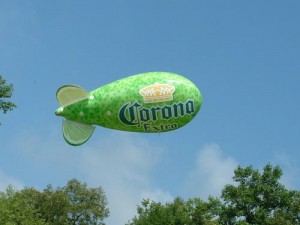Cinco de Mayo
This article was originally published on May 5, 2012. It has been slightly altered and (hopefully) improved to better celebrate Cinco de Mayo.
Author: Jim Zabek
What Day?
“On behalf of President Obama and the people of the United States, I congratulate the people of Mexico on the 201st anniversary of your independence…. We join you in celebrating Mexico’s rich history and culture and to honor the many accomplishments of the Mexican people…. As you gather with family, friends, and loved ones to hear the Grito de Dolores and the bells of independence ringing out in plazas from Baja California to Quintana Roo, know that the United States stands with you as a friend and partner. ¡Viva México! and best wishes for a year of peace and prosperity.” – Hillary Rodham Clinton, Secretary of State
Stirring and encouraging words from the United States to its neighbor, Mexico, in recognition of the celebration of Mexico’s independence from Spain. That’s well and good, but didn’t take place on Cinco de Mayo.
Huh?
That’s right, Cinco de Mayo is not the day of Mexican Independence. Secretary Clinton’s message was given in 2011 on September 16th, not May 5th.
Rise of an Emperor
Searching around the internet will yield many recent stories of how Cinco de Mayo is now known as a day of Mexican pride in the United States. But that’s not exactly where its history lies, either.
To tell the story we must first begin with a civil war, known as the Reform War, where Mexicans fought each other over the role of the Catholic Church in the affairs of the government. The conflict was bloody and costly. Upon its conclusion Mexico announced that it was broke and was suspending loan payments to its European creditors, Great Britain, Spain, and France.
In January 1862, while a civil war of its own raged in the nation to the north, forces of Great Britain, Spain, and France landed on the coast of Veracruz to persuade Mexico to resume paying its debts. Benito Juarez went into overdrive on the diplomatic front and managed to convince Spain and Great Britain that wrecking further havoc on the already heavily destroyed Mexico would fail to squeeze blood from a stone. Without firing a shot, or collecting any further promises of payment, they withdrew. France, however, was unconvinced and sent its troops forward toward Mexico City. However, along the way many of them fell ill and were forced to halt.
The Battle of Puebla, as it would become to be known, took place because of bad intelligence on the part of the French. Ready to resume his march to Mexico City, the French commander, General Charles de Lorencez, believed that the town of Puebla, and the Garrison which overlooked it and stood in the way, held fewer Mexican troops than it actually did. Additionally, he believed that the citizens of Puebla were simpatico toward the French – also wrong. The Mexican troops, under the command of Ignacio Zaragoza, were less well trained and fewer in number than the French: 4500 Mexicans to the French 6000, but still were significantly stronger than the French were expecting.
After a long day characterized by unimaginative frontal assaults on the part of the French, they were finally forced to admit defeat and withdrew from the field. Not one to miss an opportunity, a young officer by the name of Porfirio Díaz disobeyed his commander and ordered his cavalry to pursue the retreating French, who panicked and fled. Lorencez managed to rally his fleeing troops and prevent the wholesale destruction of his forces, but it was a humiliating defeat.
Thrilled with a victory over the mighty France, Zaragoza sent word to President Juarez that, “The national arms have covered themselves in glory.” President Juarez then declared the day a national holiday.
If the story ended there we might justifiably conclude Cinco de Mayo a day of significant battle, rather than minor win in a series of years filled with bad news. But the story does not end so well. When the French received word that their 6000 man expedition wasn’t up to the task, rather than surrendering they doubled down. Or in this case, quadrupled down. Elie Frederic Forey was given command of 27,000 troops, and told to march on Mexico City. He did so in 1863, rolling over the garrison of Puebla along the way. Zaragoza died of typhoid fever not long thereafter, and the French installed an Austrian as Emperor of Mexico.
Eventually (1867), President Juarez managed to evict the French, though the disobedient Porfirio Díaz would soon be elected President and, in keeping with his take-charge-regardless-of-orders style, would turn his democratic rule into a dictatorship.
From Mexican Emperor to King of Beers
Fast forward to the 1980s, when the King of Beers, Anheuser Busch, recognized a growing market to target for beer consumption. After a little brainstorming on the part of their marketing department, in 1989 Cinco de Mayo was born in America as an excuse to persuade Mexicans to drink some Budweiser.
Not to be left out of the marketing blitz, actual Mexican beer companies jumped on the bandwagon and today it is difficult to enter a bar in the United States on or about the 5th of May without being accosted by some kind of celebratory marketing paraphernalia.
And somehow, in the middle of all of this, ethnically Mexican school children, wanting to display their pride in America, have chosen Cinco de Mayo as their day to wear a Mexican flag to celebrate their…residence in America? If it seems confusing to you, it is to us, too. But there you have it – Cinco de Mayo.
¡Viva la Cerveza!
Want to game it? Check out The Cactus Throne from Against the Odds Magazine, which covers the wars during which the French were in Mexico.
Recommendation for Cinco de Mayo celebrations:






Leave a Reply